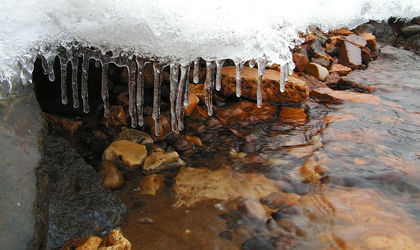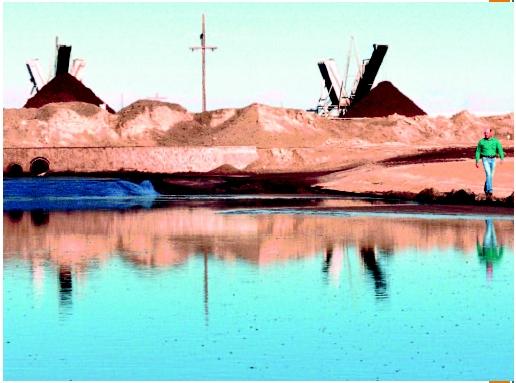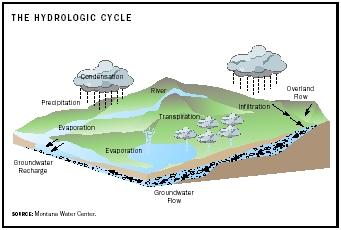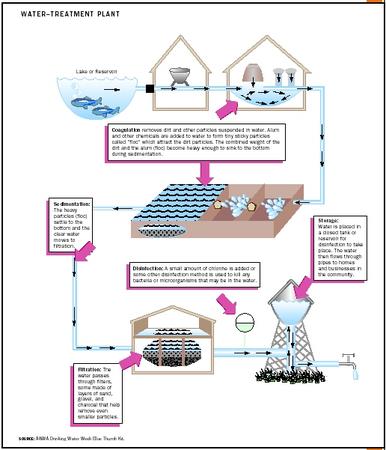Water Treatment

The goal of water treatment, usually from surface sources such as lakes, reservoirs, or rivers, is to remove contaminants and organisms through a combination of biological, chemical, and physical processes to make it safe for drinking. Some of these occur in the natural environment, whereas others occur in engineered and constructed water treatment plants. The engineered processes usually mimic or build on natural processes.
History of Water Treatment
Water-treatment concepts underlying those used today were developed in Europe during the 1700s. An outbreak of cholera in London was linked to a sewage-contaminated drinking water well in 1854. John Snow was credited with this finding. At the point in which the United States began using chlorine to disinfect drinking water (1908), Europe was also using chlorine but exploring the possibility of employing ozone to treat drinking water. The U.S. Public Health Service developed the first drinking-water regulations in the United States in 1914. The U.S. Environmental Protection Agency (EPA) later assumed responsibility for this task when it was established in 1970. The Safe Drinking Water Act (SDWA) became law in 1974, and was significantly revised in 1986 and 1996. The revisions reflected improvements in analytical methods to detect contaminants at lower levels and improvements in automated monitoring used to evaluate treatment plant performance. The revisions also started to address the need to balance immediate (acute) risks versus long-term (chronic) risks. The need to disinfect water to kill pathogens to protect against acute illnesses, versus the formation of disinfection by-products and their chronic health effects is an example of this risk balance.
The United States has continued to examine water treatment practices in Europe, particularly water-quality standards established by the World Health Organization (WHO). Although there are some philosophical differences between the United States and Europe relating to the treatment of the distribution system and its operations, the United States has benefited from the European experience. One such philosophical difference is that the European water treatment community does not see the maintenance of a disinfectant residual to the end of the distribution system as a necessary public health protection measure. The United States drinking water community sees this as an important step to protect customers and the water system from bacteriological regrowth or recontamination. As the United States entered the twenty-first century, researchers were collaborating with scientists around the world to continuously improve water quality and treatment, and openly share their research findings.
Water Quality Regulations in the United States
The EPA, under the requirements of the SDWA, regulates drinking water in the United States. The EPA additionally regulates wastewater, but under the requirements of the Clean Water Act (CWA). Storm water and discharges into surface water are also regulated under the CWA.
The SDWA sets maximum contaminant levels (MCLs) and treatment techniques (TTs) that drinking water must meet to be considered safe for

The Water Cycle
The requirements of the CWA and SDWA are different, but interrelated. Consider the water cycle and the water-use cycle. Water falls to the earth in the form of precipitation. It drains into rivers, lakes, and streams either naturally or via constructed storm-water-drainage systems. Industrial manufacturers and wastewater treatment plants discharge effluent from their processes into lakes and rivers. Under the CWA, these facilities have water-quality limits that their effluent must meet. These limits have been established to protect the water ecosystem and downstream users. Water suppliers withdraw water from lakes and rivers to be treated for human consumption and other uses. The water is treated and delivered to customers' taps through a system of pipes and storage facilities that make up the water distribution system. After the water is used, it is conveyed to a wastewater treatment plant and discharged back as effluent to a receiving water body. If the water is used outside, it either seeps into the ground or drains to a storm-water system, which may go to a treatment plant or directly to a river, lake, or another body of water. The cycle continues as the water flowing to the ocean evaporates,

Source Water Protection
Source water protection, often referred to as "watershed protection," is the reduction or prevention of water pollution at its source, represents a tradeoff between treatment plant construction and operation costs. This kind of protection is not always possible, but it has been very effectively implemented by several water systems. A water system that has access to a high-quality source may not need as extensive a treatment plant as a system with a poorer-quality source. This is especially true if a high-quality source, such as a reservoir in an isolated natural area, can be protected by limiting human activity close to that source. Water from such a source may not require the settling step, may involve fewer chemicals or smaller doses of them, or might be able to kill pathogens with strong disinfectants like ozone or ultraviolet light instead of providing filtration.
The Water-Treatment Process
Whether in the natural environment or a constructed water-treatment plant, there are several key processes that occur during water treatment: dilution, coagulation and flocculation, settling, filtration, disinfection, and other chemical treatments. The quality of the source water and the effectiveness of source-water protection and management have a direct bearing on the complexity of the treatment that is required. Source-water protection is the first step in water treatment, with the natural and engineered processes following. The processes in a water treatment plant are shown in the illustration.
Dilution. Prior to industrialization, the pollution of rivers and streams was not as significant a problem. Waste products were released into water bodies, but the quantity of such discharges was not as great as present-day levels. The receiving waters were large enough and the mixing or detention time was long enough that the contaminants were diluted to a level that reduced the

Coagulation and Flocculation. Sometimes, the particles that need to be filtered out during water treatment are very small. This makes them less likely to settle out and less likely to be filtered out. Chemicals called coagulants and/or filter aids are added to the water and mixed in (flocculated) to make the fine particles stick together to form bigger particles that can better settle out or be filtered out more effectively. Depending on the microbial and chemical makeup of the water, different chemicals are used as coagulants. The purpose of these two steps is to improve the performance of the remaining treatment processes.
Settling. For facilities treating water that contains a lot of solids, settling or sedimentation is a common treatment step. The process slows the flow of the water in a pond or basin so heavier items can settle to the bottom. If the water is not sufficiently slowed down, these items are carried along to the next step in the process, which is not desirable. For plants treating very polluted raw water , settling may be used as the first step in the treatment plant (presedimentation) and again following the coagulation and flocculation steps.
Filtration. There are several methods of filtration used in water treatment. The selection of which type to use is generally a function of the raw water quality. As filtration implies, water flows through a material that removes particles, organisms, and/or contaminants. The material used is most often a granular medium such as sand, crushed anthracite coal, or activated carbon. Some facilities layer different types and sizes of media. Along with varying the size and type of filter media, facilities are also designed to operate at different flow rates through the filter media. Traditional filtration plants include slow sand filtration, high-rate filtration, and diatomaceous earth filtration.
Another type of filtration that was more widely used in the late 1990s and early 2000s is membrane filtration. It occurs by forcing water through a membrane barrier. A membrane is like a high-tech coffee filter. As water under pressure flows through the membrane, contaminants and organisms are captured on the membrane and not allowed to pass through. Membranes are not well suited to highly contaminated source waters because the solid materials clog up the membrane almost immediately. Membrane filtration is gaining use in the United States for special applications and in combination with other types of filtration.
Disinfection. Filtration and the steps prior to filtration focus on the physical removal of contaminants in the water. In addition to physical removal, it is still important to provide chemical disinfection. Disinfectants used include chlorine, chloramines (chlorine plus ammonia), ozone, ultraviolet light, and chlorine dioxide. Chlorine was first used in the United States in a water-treatment plant in 1908.
The advantage of chlorination is that it continues to kill bacteria as water moves through pipes to the tap. Its disadvantage is the possibility of disinfection by-products. Excess chlorine in water can combine with organic material in the water to form substances such as trihalomethanes, which can cause liver, kidney, or central nervous system problems, and are linked to an increased risk of cancer over a lifetime exposure.
Disinfection is needed to inactivate (kill) bacteria and viruses that make it through the physical removal (filtration) steps. Viruses and giardia are effectively killed by chlorine. Over time, scientists have found that some organisms such as Cryptosporidium are resistant to chlorine. Cryptosporidium rose to public attention in 1993 when it sickened over 400,000 people, killing a hundred, in Milwaukee, Wisconsin. Largely because of this scare, new or amended U.S. drinking-water regulations developed early in the twenty-first century that expanded water treatment requirements specifically to address Cryptosporidium. Although chlorine is not effective against Cryptosporidium, alternative disinfectants such as ozone and ultraviolet light do appear to be effective at killing it. In Europe, both of these disinfectants are often used without chlorination to kill bacteria in the water supply.
An amendment to the SDWA requires that all sources of potable water in the United States be filtered. In some locales throughout the nation, such as Boston and Seattle, reservoir water is essentially free of organic matter, and municipalities have been able to avoid filtration because they have extensive watershed protection and management programs in place.
Other Chemical Treatments. Chemicals are added to drinking water to adjust its hardness or softness, pH, and alkalinity. Water that is acidic is very corrosive to the pipes and materials with which it comes into contact. The addition of sodium hydroxide can reduce corrosivity and extend the service life of pipelines, storage tanks, and building plumbing systems. Pipes may also be coated with chemicals to prevent metals like copper from dissolving in the water. In addition, chemicals are used to reduce the leaching of lead from old lead pipes and lead-soldered copper supply pipes. Fluoride is frequently added to the water in many communities to improve the dental health of younger residents.
Groundwater Protection and Treatment
Wellhead protection is critical to preventing the contamination of ground-water supplies. Groundwater is pumped out of an aquifer, which is like a small underground lake surrounded by layers of rock and soil. Water from the surface flows through the rock and soil to get to the aquifer. The earth naturally provides filtration of microscopic pathogens. It does not always provide adequate protection against viruses or chemicals that are dumped on the ground. Groundwater typically contains higher concentrations of metals like iron and manganese because these metals occur naturally in the earth. Groundwater may also be much harder than surface water. Processes similar to those outlined above are also used to treat groundwater, except that the filtration steps are often focused on removing chemicals or metals rather than pathogens. Some groundwater supplies are not treated at all, while others may be filtered and disinfected. As with surface waters, the quality of the source dictates what treatment steps are required.
Regulatory Reporting and Public Education
Water systems in the United States submit reports each month to state or federal regulatory agencies, summarizing treatment-plant performance and sampling results. The majority of medium and large water systems in the United States have staff working twenty-four hours a day. If something were to go wrong at the plant, the plant operators have procedures that they would follow to shut down the plant, switch to alternate equipment, adjust chemical dosages, or collect additional samples. State and federal regulations specify when the water plant operator must notify the state or federal agency, and these requirements are built into the plant's procedures. The regulations also specify when the public must be notified. Orders to boil the water are usually jointly issued by the state health agency and the drinking-water system quickly after a problem has been discovered (most likely via telephone and radio). Public notices about problems with routine monitoring results or the failure to collect required samples would generally be distributed in the newspaper or via the water utility's annual water quality report (also called a consumer confidence report). The requirement that all water systems compile and distribute a user-friendly report began in 1998. This report provides an overview of the water-system activities and compliance with regulations for the year, as well as identifying ways that customers can get involved or acquire more information.
SEE ALSO A GRICULTURE ; C RYPTOSPORIDIOSIS ; G ROUNDWATER ; H EALTH, H UMAN ; N ONPOINT S OURCE P OLLUTION ; S NOW, J OHN ; W ASTEWATER T REATMENT ; W ATER P OLLUTION .
Bibliography
American Water Works Association. (1999). Water Quality and Treatment, A Handbook of Community Water Supplies, 5th edition. San Francisco: McGraw-Hill.
American Water Works Association and American Society of Civil Engineers. (1998). Water Treatment Plant Design, 3rd edition. San Francisco: McGraw-Hill.
Peavy, Howard S.; Rowe, Donald R.; and Tchobanoglous, George. (1985). Environmental Engineering. McGraw-Hill Series in Water Resources and Environmental Engineering. San Francisco: McGraw-Hill.
Symons, James M. (1992). Plain Talk about Drinking Water: Answers to 101 Important Questions about the Water You Drink. Boulder, CO: American Water Works Association.
Internet Resource
U.S. Environmental Protection Agency, Office of Water Web site. Available from http://www.epa.gov/ow .
Julie Hutchins Cairn
One of the problems in protecting drinking water is that by the time results of tests for E. coli or Cryptosporidium or even anthrax are known, an urban population can already be at risk. Inventors Gregory Quist and Hanno Ix are out to change that. They use laser beams to scan a flow of water; particles in the water scatter the light beam and each scatter pattern is different. A computer analyzes the pattern and provides continuous real-time identification of microorganisms. The system is being tested at a Los Angeles, California, water facility.